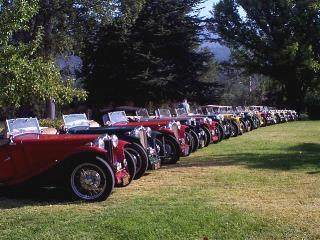
Bill's Page
Following is a one page jumble of my (too) many areas of interest and research.
MG Sports cars:
My interest in MG's goes back to the early high school years. My folks planned on handing me down the '57 Chevy, but I was more focused on those small, open top, long hood, swooping fendered cars I saw darting through traffic. My friends and I plotted and planned on how we could get our hands on a sports car. In our senior year, Lou showed up in an MG TD, and my first ride in that car made me determined to have a TD of my own. Paul (another sports car dreamer), found a book titled "How to Buy a Used Sports Car" by Christy. That book had a chapter devoted to the MG TC...and I was sold! In February 1967 I somehow convinced my folks to loan me the money to buy a TC (chassis #5221 built April 8, 1948). Repaying that loan took two years of part-time work including a summer job at the local Dole Pineapple cannery.


Abingdon Rough Rider / LA TC Motoring Guild 43rd annual conclave, Sierra Sky Ranch, Oakhurst Calif., Oct 1-3, 1999. Red TC, left photo, nearest is #5221.
There are 17 MG TC's in line-up. The two TC clubs have been meeting half way between LA and SF since 1957. The Sky Ranch photo is one of our best line-ups.
The photo below is the 48th Conclave was at Cambria, October 8, 9 & 10, 2004. We had 15 TCs at the event, 14 made the 'line-up'. The location is Moonstone beach near Morrow Bay. Our 63rd Conclave is scheduled for October 3rd thru' the 5th, 2020; location to be determined.

The MG TC was built from November 1945 until November 1949 at Abingdon, England. 10000 (#0251 to #10251) were made and ~2001 were shipped to the USA. The first MG's were modified from Morris cars in about 1923 for those wanting more power and performance. The first production MG (Morris Garages) was the M type (1929 to 1932) using Morris chassis and components. The first MG that was designed from the chassis up was the J2 (1932 to 1934).
I have had the TC since 1967, driving it to school and work until 1970 when I retired it with a 1967 MGB / GT. In 1971 I bought a 1933 MG J2.
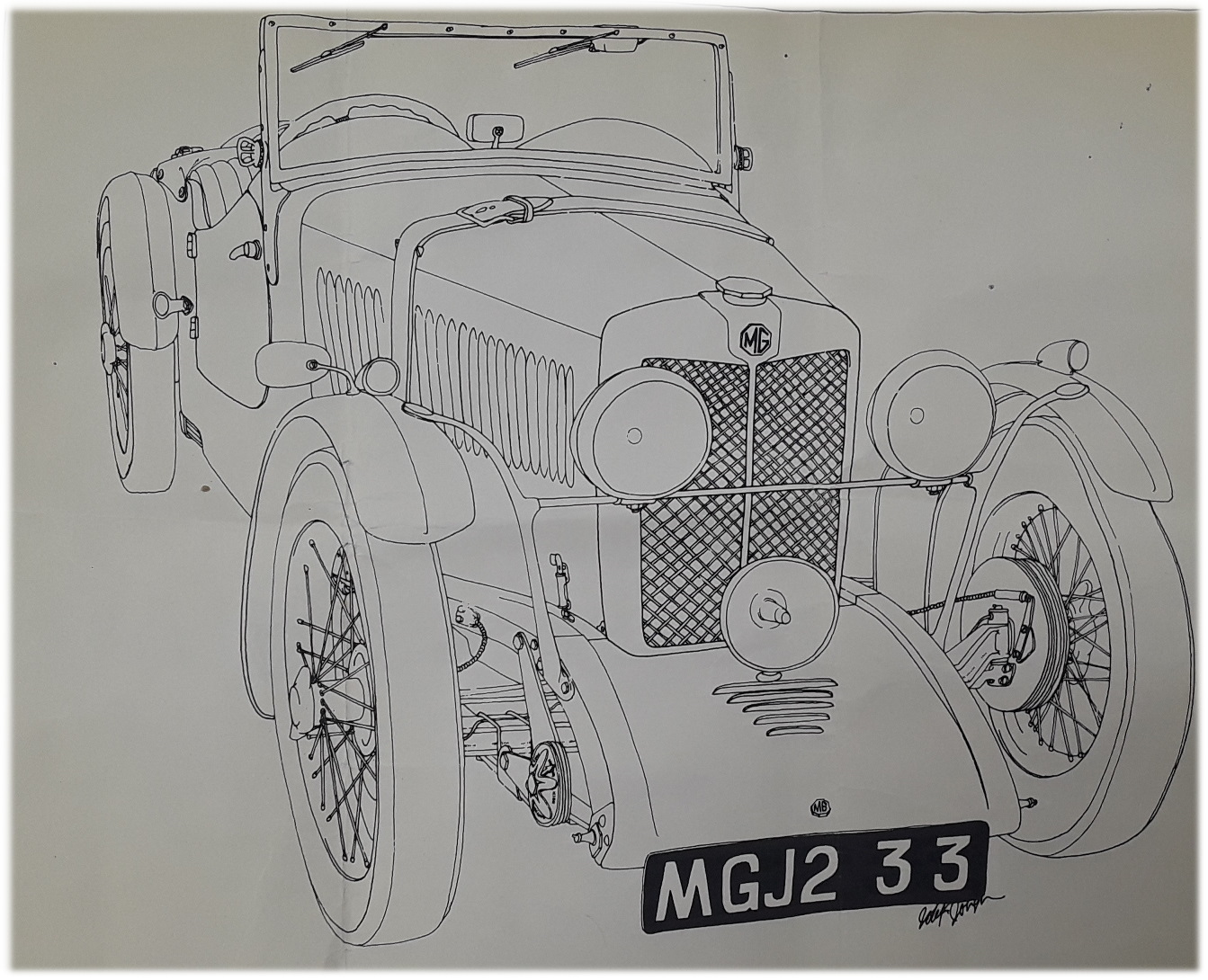
The above line drawing is of my J2 when in the ownership of the late Mr. John Johnson. John was a graphic artist creating rallye posters for local sports car clubs.
The TC I drove about 80,000 miles, from San Diego to Vancouver Canada and as far East as Denver Colorado. The MGB/GT I have driven 280,000 miles (retired in 1989, awaiting restoration). The J2 was purchased as a "basket case" and is just emerging from a dormant restoration and I hope to have it on the road by...2021.
-------------------------------------------------------------------------------------------------------------------------------------------------------------------------------------------------------------------------------------------------------
Antique engines & tractors:
My interest in "old iron" dates back to the pre-school years. My parents were in gold and tungsten mining in the Greenhorn Mountains, east of Bakersfield, California. We lived in a log cabin on the Caliente-Bodfish Road. No electricity, no gas, no plumbing, wood for warmth and cooking, a cool clear spring for water.
I grew up around mining equipment, clambering up and down mine shafts, creeping through dark damp tunnels. I was fascinated by the big diesel engines, rock crushers, ore cars, concentrating tables. We had a dump truck, a 1927 Moreland truck with chassis mounted Waukesha engine driving an Ingersol air compressor, a 1936 Dodge school bus converted into a first class motor-home and two Model A Fords for getting around; my favorite one was the 1929 with soft top and rumble seat.
When I was six years old we moved back to civilization, San Bernardino, California. Although most of all that cool "old iron" and Fords stayed behind after the move, we spent weekends and summers exploring mining camps and ghost towns through-out the Southwest states.
We moved to San Jose, California in 1962 and since 1980 I have been collecting locally manufactured historic "old iron" and researching the people behind those companies.
For the past forty-two years I have been half owner of Clover Machine & Manufacturing, located in Santa Clara, Calif., making components for lasers, ultrasound and other hi-tech medical equipment. We founded the company in a garage, not knowing anything about running machine tools, to build obsolete parts for, what else?, MG's. After a few years we began to receive requests for prototype work from local hi-tech companies, and that lead to volume production.
Following are two of the more interesting items from my low-tech / old-tech collection...with a little history thrown in.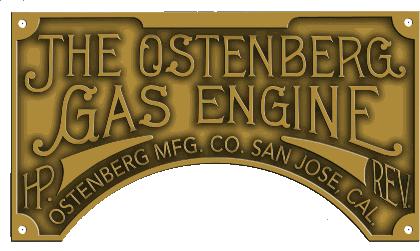
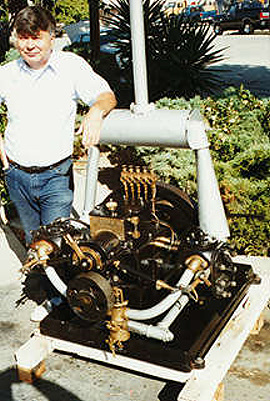 Me and the Ostenberg Gas Engine.
Me and the Ostenberg Gas Engine.
I missed this engine by one day in 1975 by choosing to attend a local MG event instead of visiting a yard sale at a long derelict apricot drying and packing shed located nearby in our east foothills. I soon learned of my error; sold the day before for $75.00. Several years later I finally took up the standing offer to visit the new owner; I move slow, but eventually a phone call leading to years of enjoyable friendship, I was able to acquire this historic California built engine.
The Ostenberg Gas Engine was built in San Jose, California from 1903 to 1912 by Swedish immigrant John A. Ostenberg. John was the designer and factory superintendent of the Abenaque Gas Engine Company of Vermont. He and his family moved to San Jose in 1898, purchasing a 15 acre orchard off Redmond Road. Today, the orchard is a housing tract, but Ostenberg Drive commemorates the family home site.
The factory was located in the "Willows" near the present corner of Bird Ave. and Willow St. The factory was sold to the John Bean Spray Company in 1912 and production continued for three more years. Bean redesigned the engine in late 1913 and called it the "Bean Double Opposed" engine. It is unknown if production serial numbers started at 1 or 100, but production stopped at serial number 434 as noted in production records. The oldest engine, of seven survivors, is #129 the newest is #355. The change of ownership occurred between engine #236 and #290. This engine is #227. I believe Caton Iron Works of San Jose, made and performed the heavy machining for the Ostenberg factory. Caton's was purchased by the John Bean Company about the time Bean acquired Ostenberg. The Ostenberg engine used a Caton water pump for cooling water circulation. Offered as an option was a Henricks Novelty Company ignition generator.
Note...The John Bean Company merged with Anderson Barngrover 1927. The merged company became the Food Machinery and Chemical Corporation 1929. FMC built food processing equipment from farm to canning. WW2 the company entered the 'military industrial complex' building invasion landing craft ending production with the Bradley Fighting Vehicle.
The Ostenberg Gas Engine was built in 10, 15, 20, 25, 32 and 40 horse, all identical in design just larger. All the Ostenberg engines were ignitor fired. The Bean Double Opposed engine used a Bosh DU-2 HT magneto and spark plugs. The 10HP Ostenberg had the option of hopper cooled cylinders vs. the enclosed system as pictured.
This above engine is a 10 HP, 43" wide from cylinder head to cylinder head, weighing 950 pounds. For comparison, the 40 HP was 76" wide from cylinder head to cylinder head, weighing 3800 pounds. One 40 horse survives, one 32 horse survives, one 20 horse survives and four 10 horse survive. Only one of the seven surviving engines is a Bean Double Opposed, it is a 10HP and has just returned home to San Jose. Rumored engines are: one that was donated to a local museum and has since disappeared (Double Opposed), one buried in a pump pit on a San Joaquin Valley ranch sixty years ago and another in a wood shed in Oregon. I have a name plate and exhaust system from 40 HP engine #123. Sara Winchester of the famous San Jose 'Mystery House', owned an Ostenberg (40HP?) and author Jack London had an Ostenberg at his Sonoma County California, ranch; now a State Park. Wonder if it is still there in a shed?
10HP Ostenberg #129 is owned by the Monterey County Ag Museum but not generally on display. It is same design in castings but different in detail. The drip oilers are not in a 'gang' as on #227 and there is an internal fly-ball governor vs. the governor of #227 external but internal to the front pulley. I have rebuilt the governor on #129 and aided with retired park ranger Mr. Oats in getting it up and running. Several years ago we had both #129 and #227 running together at the park 4th July.
Anyone with an Ostenberg Gas Engine...? I'd like to add you to my list.
The Ostenberg engines were painted in a variety of colors just as the Vermont Abenaque engines under John's management. Engine #227, pictured, was white in color. I did not realize this till touching up the black paint from prior times; someday I will repaint using the maroon color option.
The John Bean Company built and offered the ignitor fired Ostenberg engine till end of production approximately 1916, but concurrently redesigned and built the "Bean Double Opposed" with Bosch magneto ignition; painted brewster green in color. I have the complete original factory production cost of each engine component right down to 15cents of paint. This wealth of information was rescued from a FMC company dumpster by an employee when 'Airline Division' was being closed down, and since passed on to me by Mr. Richard Hamp.
John sold his Ostenberg Gas Engine company for $75,000 and soon purchased the Victory Automobile Company shop. Victory had built automobiles in San Jose early 1900's and later became a general machine shop and automobile repair; 'Victory' referring to the then recent Spanish-American war. John used this new resource to design and build the Victory Oil Engine. Production began in San Jose with the 20HP Victory 2 cycle oil engine, but the city would not allow John to build a cupola to process iron into castings. John, and partners, then moved the Victory company to Niles California and purchased the derelict Ames Pump Company factory. The Victory company invested heavily in stocks of cast iron scrap and ingots just after the world war and thus did not have enough liquid assets to weather the business recession after the war; closing shop by 1927. The son of Mr. James, president of Victory (John was chief designer and inspector), gave me much information on the Victory Oil Engine Company.
The Victory Company also manufactured bronze valves. Mr. James Sr. would return home to San Jose after work bringing small valves for his children to wrap and package, and they seemed to enjoy the chore.
The James family children would sometimes go with the installation crew out to farms and ranches for the day. They said it seemed they were more often than not in Mendota California installing Victory engines for pumping...any still there? The foreman of the install crew kept a personal log book of all Victory installations, what a find that would be!...I have tried.
The Victory engine was great under constant load such as pumping but was not good at variable loads as in hoisting etc. The factory suffered from bad castings resulting in custom made cylinder bores and thus custom made pistons all resulting in a lack of standardization of replacement parts. By 1920 electrification of our rural farms was the beginning of decline in business.
There is a scruffy alley running behind the Niles main street frontage called Victory Lane. I have often wondered if it commemorates the Victory Company as it appears to lead straight to the old site south of downtown.
A Mr. Henry Dahl, at age 96, was still a machinist at Western Forge and Flange. I briefly spoke to him at his work one day in ~1980. Our later meeting was postponed due to his illness from which he did not survive. He worked for Ostenberg at the 'Willows' site and John Bean after they acquired Ostenberg. Later, he worked for Victory. From him during our short workday meeting, I recall John broke from engine color tradition; all Victory engines were painted black.
Sometime prior to 1923 John became estranged from his family, moved to Los Angeles, later returned to San Jose and died of Parkinsons in 1927 age 68; his last days spent in care at our county hospital. His pauper's remains were cremated; his ashes remain unclaimed to this day at Cyprus Lawn Cemetery, Colma, California.
John's sons, Zeno, Pontus and Nero went on to success. Pontus and Nero with the Ostenberg Deep Well Pump Company, San Jose. Zeno graduated Stanford University, chemistry 1912 and was one of the founders of Milpitas California; becoming their first building inspector 1954. The daughters, Grace and Daisy I know little about them but none of the children of John and Amalia had children of their own as far as is known.
I could have met Daisy (1898-1992), back then, but misspelled the name as I did not have the engine; she was in the phone book. She passed-on leaving no heirs...opportunity missed!
I am interested in learning of John's family history in Sweden. He was born September 30, 1859 to Frank and Kathleen (Johnsson) Ostenberg. Any information will be appreciated.
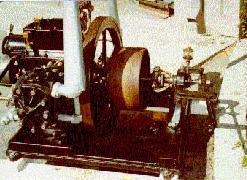
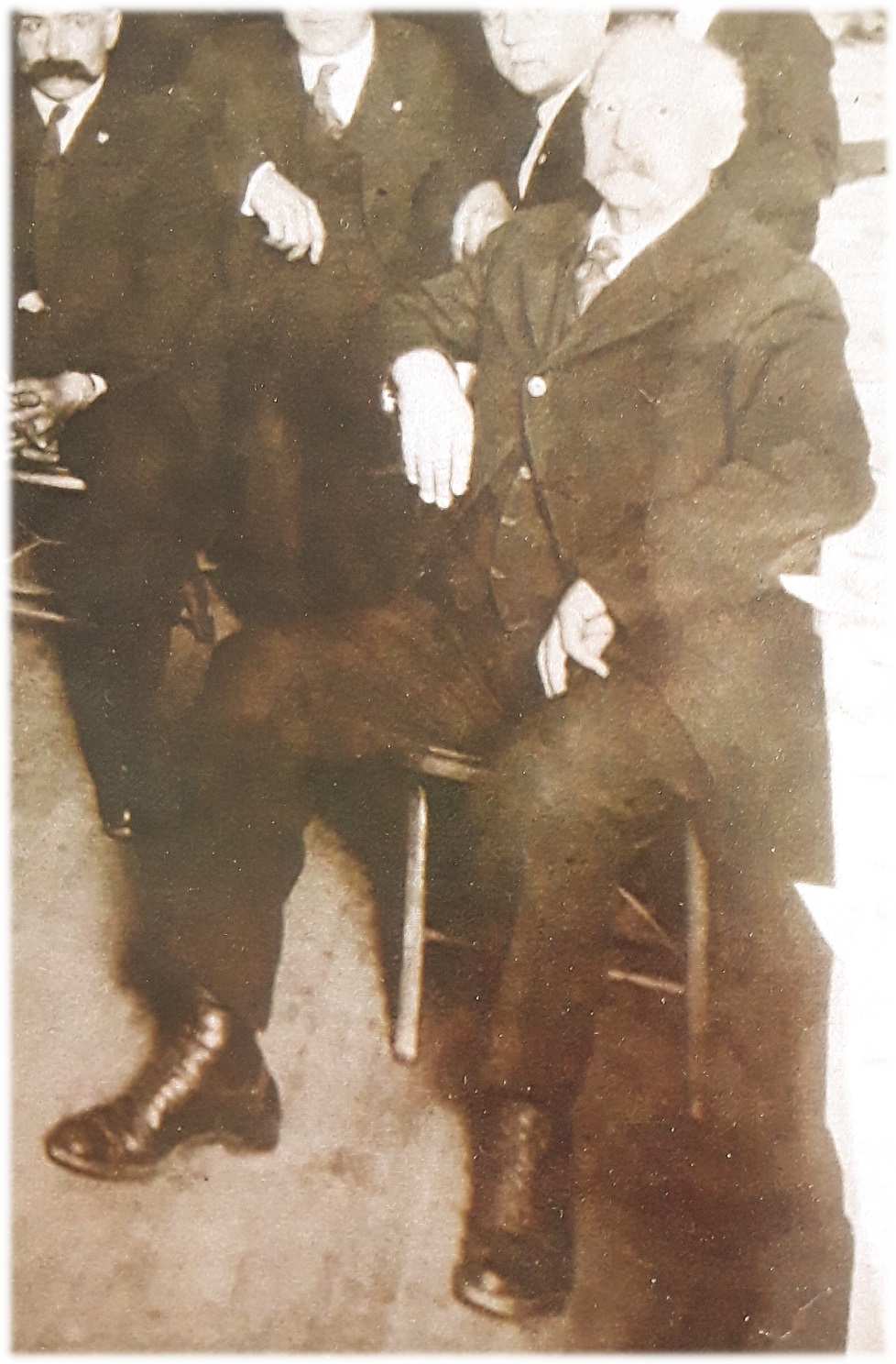 John A. Ostenberg at Victory Company Christmas party 1922
John A. Ostenberg at Victory Company Christmas party 1922
-----------------------------------------------------------------------------------------------------------------------------------------------------------------------------------------------------------------------------------------------------------------------------------------------
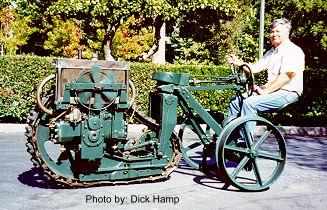
Not much is known about this machine patented by James H. McCollough in 1927 (granted 1929). The original owner claimed it was purchased from the John Bean Spray Co., San Jose, California.
James H. McCollough and Alfred C. Johnson teamed up in 1906 to form a 30 year partnership designing and building some of California's early gasoline powered farm tractors.
Their first production tractor was built in 1910 at Sunnyvale. The factory was soon sold to the Joshua Hendy Co., also of Sunnyvale, and production continued until about 1913. That tractor was the “Johnson Improved Tractor” and the only known survivor is located at the Pioneer Museum, Paso Robles. Hendy sold the rights for this tractor to the Rumley Company of Racine Wisconsin and a small number were built as the "Rumley Toehold" tractor.
In 1912, Alfred Johnson, James H. McCollough and Fred Calkins of San Jose, acquired a 2/3 interest the ball tread patent of Mr. Clarence Henneuse and development began on the "Calkins & Johnson Ball Tread" tractor. The Ball Tread tractor company was headquartered in San Jose for a short time until bankruptcy forced the sale of the company, located on South First St., to the Yuba Construction Co. of Benicia.
Their next tractor was developed and built in San Jose and was very quickly purchased by the John Bean Spray Co., and built at their Julian St. factory. That tractor was the famous “Track-Pull” built from 1915 through 1921. The Track-Pull was a design predecessor to the machine pictured here. Johnson and McCollough were retained by the John Bean Company to continue developing the design and production methods.
James H. McCollough maintained offices in the First National Bank Building, San Jose, from 1920 through 1927 as a “tractor designer”. By 1930, as the great depression took hold, he was in “real-estate”, probably developing his “Sunnyvale orchard” for much needed cash. He then vanishes from the record books for a few years, and in 1935, surfaces in Alameda where he and Johnson again try their hand in tractor design and production, building a similar but smaller machine called the "Unitrack". The Unitrack used an Indian motorcycle engine for power. One Unitrack is known to survive (serial #11).
“Alf” Johnson continued to design and consult for the John Bean Spray Co. and their successor, Food Machinery & Chemical Corp., until his death in 1954. He died while developing a new tractor at a field trial in Sunnyvale.
This machine is the only known example of perhaps a very few built and was little used as all internal mechanical parts show no wear or abuse. The engine is 2 cylinder opposed displacing 88 cubic inches with ball bearing mains, phosphor bronze connecting rods and cast iron pistons. The transmission is planetary, using model T Ford components allowing one speed forward and a very slow reverse. The University of California Davis has a photo of this tractor on field trial but without the radiator (condenser) and fan. It appears they initially tried to use a hopper cooling system but was found to be inadequate.
I am also interested in the family history of James McCollough and Alfred Johnson. James McCollough was born in San Francisco, California in 1881. Alfred Johnson was born in Iowa 1881, but the family soon moved to Winters California.
The two nieces of James McCollough found this website and we exchanged much information. James and Alf went on to design and build an airplane engine in Alameda, California. One such engine survives in the Wright-Patterson Air Force Museum.
Patent drawing of the 1927 tractor. Use the browser "back" button to return.
Photo of the 1935 Unitrack.Use the browser "back" button to return. Tractor now restored to operating condition by current owner.
-----------------------------------------------------------------------------------------------------------------------------------------------------------------------------------------------------------------------------------------------------------------------------------------------
Model Steam Railroading:
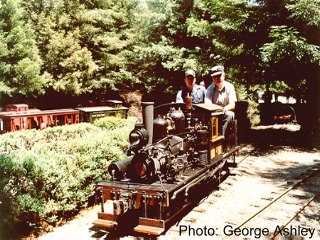
This is a 15 inch track gauge model of a Shay locomotive built to 5" to the foot scale by Ken Kukuk. I have not built one of these engines but have contributed to some of the locomotives built by our network of "15 inch gagers". This railroad is the Redwood Valley Railway located at Tilden Park in the hills above Berkeley Calif. There are about ten 15" gauge railroads in our State. My "home road" is the Glenwood South Park and Pacific located in the Santa Cruz mountains West of San Jose, and the Shay is GSP&P #7. Robert Beuttler is the engineer (on left) in photo and I am (on right) "firing".
The locos are diesel oil fired with a boiler pressure of 150 to 200 pounds/sq inch. Firing the engine is more fun than driving. A fireman has to adjust the fire for maximum efficiency and believe me efficiency is necessary! The GSP&P has 8% grades to climb and the Hetch Hetchy & Yosemite Valley near Toulumine, Calif., is a 25 minute round trip.
The water in the boiler must be kept at the correct level by use of injectors. Too much water and it will work into the cylinders causing mechanical disaster, too low and the crown sheet (between the fire and the water) may warp resulting in expensive repair. The fire must be regulated constantly according to road conditions. Running down-hill, on the level or up-hill is each a balancing act of the roar of the fire and the force of the injectors.
The engineer's job is no piece of cake either. The throttle valve must be operated with a fine touch. Opening it too much and the locomotives wheels will spin and the fire almost certainly will be pulled out of the fire-box necessitating a shut-down of the fuel system and going through the relight procedure. The engineer is responsible for train braking and safety. The brakes are air operated from a reservoir supplied by a steam air pump. On a long downhill run the air reservoir can be depleted by inexperience and a runaway train without brakes can be disastrous!
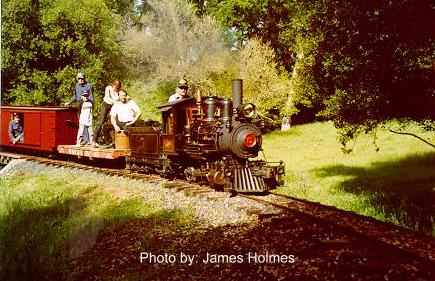
This is GSP&P's #5 climbing a grade on the Hetch Hetchy & Yosimite Valley's Railway. Engineer is Gerry Hanford. Erich Thomsen, in blue shirt, is standing on flat car and Ken Kukuk is inside the box car.
Most all of of our equipment is based on Erich's designs. He was the roadmaster for the Western Pacific Railroad for 27 years and made a study of all aspects of railroading. Ken is the builder of the Shay and the #5.
CLICK HERE to go to the GSP&P Railway page.
-----------------------------------------------------------------------------------------------------------------------------------------------------------------------------------------------------------------------------------------------
Volunteer projects:
Currently, I am not actively volunteering on any projects, just too far behind on my own!
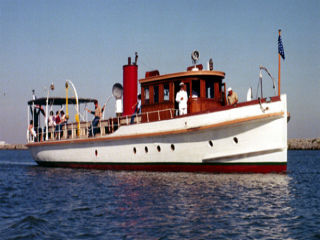
I spent 10 years helping to restore and operate the M. V. Suisun, an ex Army Corps of Engineers survey motor vessel built in Astoria Oregon in 1914. It's engine was built in Petaluma, California, by the Corliss Gas Engine Company. The Suisun is 86 feet long displacing 72 tons in cruising trim. The Corliss engine is 175 HP 6 cylinder 10" x 12" bore and stroke weighing 18,000 pounds. Both the vessel and engine survive but no longer together due to explosion and fire in 1987.
She was constructed of the finest materials available. With a crew of fourteen she surveyed the California coast, San Francisco Bay and Delta to make sure the commercial waterways were clear and open. Survey work included the fill for the Panima Pacific Exposition of 1915, the construction of the Carquinez Bridge and always on look-out for illegal fishing activity. In her "grand salon" dining room many area notables were dined including Sunny Jim Rolph the flamboyent mayor of San Francisco. The Suisun was retired from government service in 1931 and purchased by the Skaggs family, owners of Safeway and renamed the "Virginia S.".
Her log books are a wealth of historic information. For instance, on May 2, 1915 she motored up the Guadalupe River, from Alviso toward San Jose, four miles with an average water depth of twenty two feet! Today the Guadalupe is more like a creek than a river.
In 1954 the Suisun was used to film John Wayne's "Blood Alley". Mr. Wayne is reported to have come aboard very late one night, with whisky bottle in hand, lowdly asking if "anyone aboard this boat, alive or dead, will have a drink with me!"
One of our last trips was to take seven astronauts on a tour of the San Francisco Bay. They were members of the Association of Space Explorers, the international professional society of astronauts and cosmonauts.
We had aboard Rusty Schweickart, Apollo 9; Alexi Leonov, first man to walk in space, and five others from Russia, East Germany, Saudi Arabia and America, and a boat load of officials and KGB body guards...complete with fedora hats and trench coats. In the wheel house I spoke to five of the Russian officials as they asked the history of the boat, the surrounding sights etc. One of them just smiled and never said a word, so I figured he did not understand me, but I pretended he did. Later, as they were leaving, he grabbed my hand and said "thank you for speaking to me, Bill". I asked Mr. Schweickart who he was...the head of the Russian space program!
Another of the engine crew, Chuck Hopkins, and I found Mr. Leonov alone in the dining salon and told him it was an honor to have him aboard. He placed three drinking glasses on the table and 1/2-filled them with 80 proof Stolichnaya Vodka and proposed a toast to the American and Russian people in friendship, and proceeded to knock back the whole glass...we did likewise. As I set my glass down it was filled again in toast to the American space program. I set that glass down for the third time, wondering what my mental state would be in a few minutes...it was filled again!...in toast to the Suisun's crew volunteering their time to the restoration of the vessel (which he wished he could take home to Russia). I didn't set my glass down for a fourth round...and still have the empty bottle of Stoli as a reminder of that day.
Reciently, I learned form a Russian that when you have had enough of toasting, you smash your glass, or, place it on the table up-side down. I wonder if he was impressed with us.
Our Chief engineer, Tom Walsh, suggested I take our engine room log book and have all the astronauts sign it. One of the astronauts, Loren Acton, over-heard the suggestion and volunteered to introduce me to each of the space voyagers. After making the rounds he wanted to see who we had missed...Rusty Schweickart. Feeling cavalier after the three glasses of Stoli, I said "hey,where's Schweickart!". A man standing right behind me said "I'm Schweickart!" I felt like a small rodent; disrespectful to our national hero. Mr. Schweickart gave me a big smile and said "shure, I'd like to sign your log".
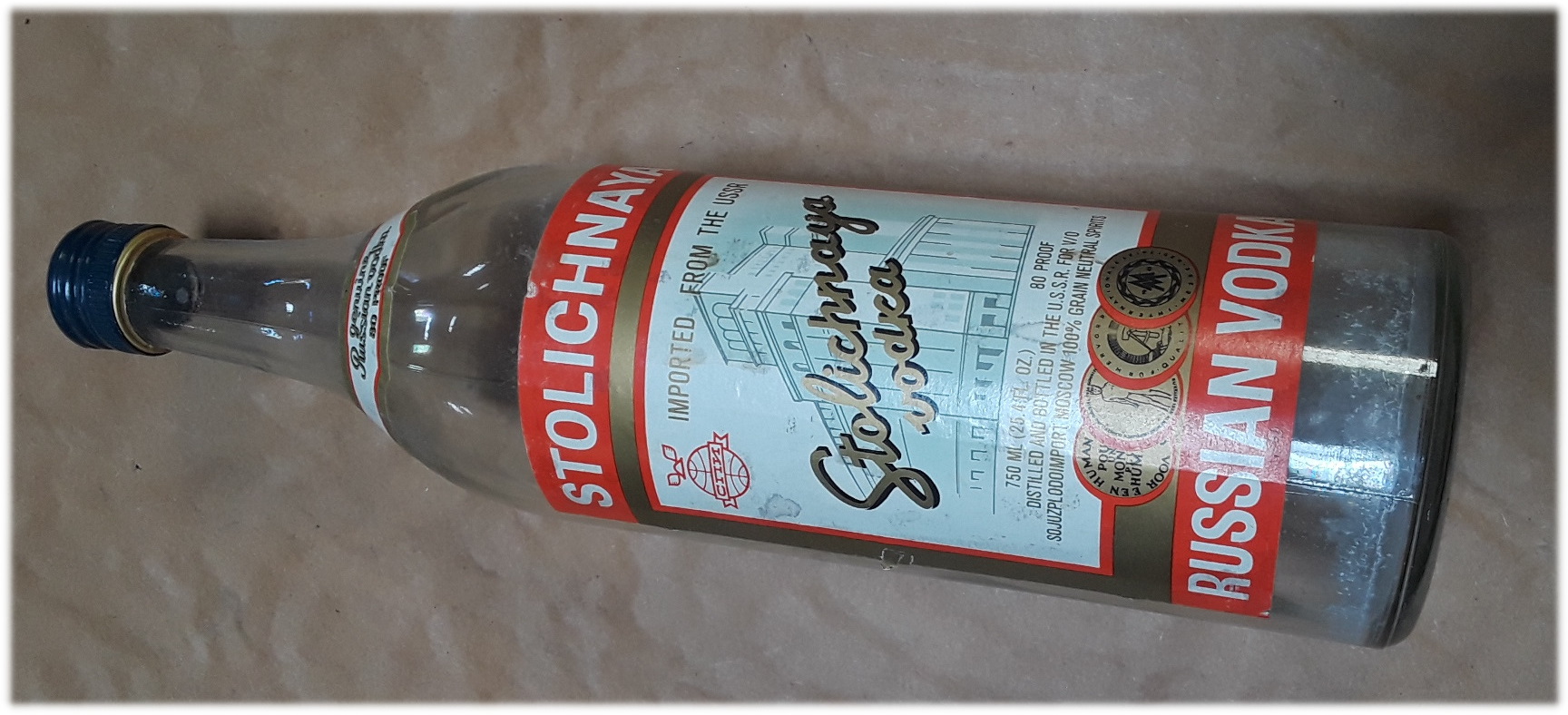
----------------------------------------------------------------------------------------------------------------------------------------------------------------------------------------------------------------------------------------------------------------------------------------------

I worked on the steam tug Hercules one or two Saturdays each month from 1980 to about 1988. Myself and several others scraped paint and rust, polished lots of brass and retubed the boiler. A new group moved on board in 1988 and has taken all the credit for bringing her back to life. My hundreds of hours of labor and donated machine work do not appear on the contributors board. The Hercules is located at the Hyde Street Pier, San Francisco, and is the property of the National Park Service.
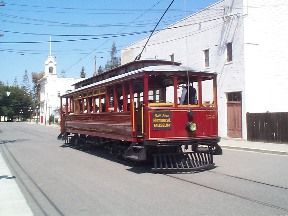
I have machined several items over the past years for our antique trolley cars that operate here in San Jose, and have helped (a little) in re-assembly of the San Jose History Park's (Kelley Park) Port Huron steam traction engine. I am currently on duty one or two weekend days each month as a docent/host at the Kelley Park Trolley barn.
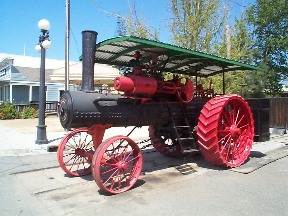
On the lookout for old friends...
My mom had not been doing well for awhile and was diagnosed with an inoperable lung/aortic tumor in June 1975 and we lost her in December of that year. My father soon was diagnosed with ALS (Lou Gehrig's) and began a rapid decline. I dropped out of SJSU in 1975 (9 units short of a BA), eventually quit my job and took care of him at home 24/7. 1975 thru' 1977 was a difficult time and I lost contact with many wonderful people.
Anyone who worked for Mail Delivery Service Company ( MDS ), San Jose, California., 1968 to 1976.
San Jose State University, 1970 to 1975.
Marilyn Hopper MDS 1974/1975 & SJSU (elementary education) 1972/1977,Home town: Ventura, California.
Photo June 3,2014 of the San Jose MDS employees at Sara's Kitchen, Santa Clara, California. Some of us started with the first or second offices located on San Pedro St. San Jose that were prior to the Bassett St. Office; 1968 - 1974. The first office on San Pedro St., was a small desk in a un-used corner of the Rose-Murty Tire shop. That was just before 'my-time' and probably why all our vans forever-after ran on their $6 recaped tires!...loyalty.
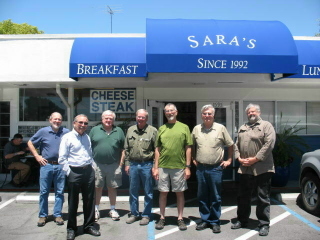
LtoR: Jack, Lou, Kent, Jeff, Bob, Bill, Gary
There are others who live too far away or their work schedules too tight to make our lunches but keep in touch. Bob happened to be visiting from New Mexico. Why are we still friends after nearly forty years...because many of us were friends long before employment at MDS. Some from grade-school, college, four of us pictured owned T-series MG cars, four of this group are active sail-boaters, two often fish the Sierra rivers and are MG car guys too. One of us is a combined artist, boat builder/sailor, an MG owner and a fisherman. Two of us are grade-schoolers and MG owners. Many of us discovered common interests at the company. A Venn diagram of our group would be interesting.
I have to say that more than half the fun of these projects involving old cars, tractors, steam locomotives, boats etc. are the friends I have made over the years. We have shows, tours, conclaves, BBQ's and share information for all the books we intend to write...someday.
Email: bill @ traill.us spaced in attempt to foil email harvesters
Last updated on: March 24, 2020